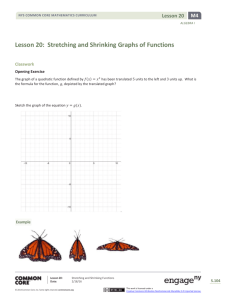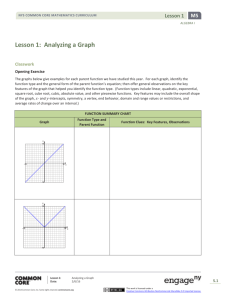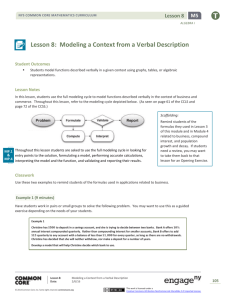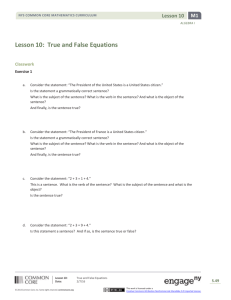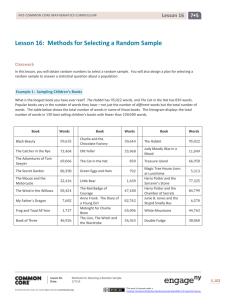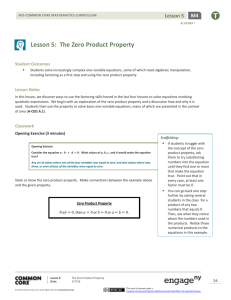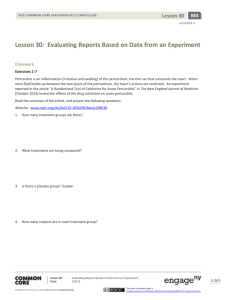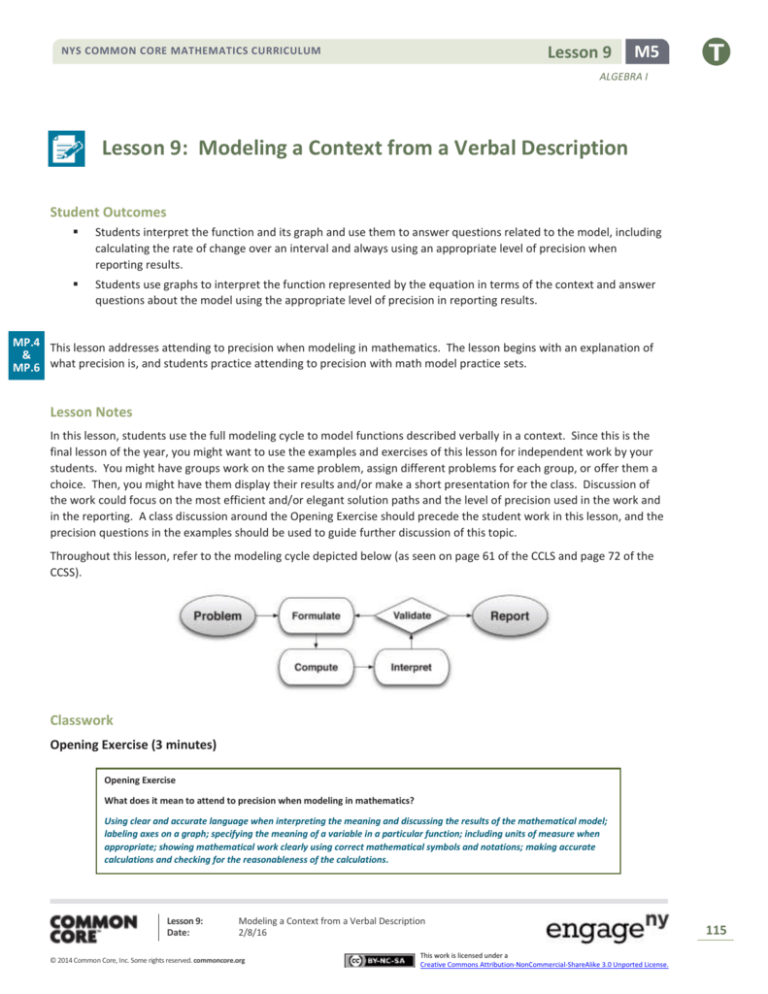
Lesson 9
NYS COMMON CORE MATHEMATICS CURRICULUM
M5
ALGEBRA I
Lesson 9: Modeling a Context from a Verbal Description
Student Outcomes
Students interpret the function and its graph and use them to answer questions related to the model, including
calculating the rate of change over an interval and always using an appropriate level of precision when
reporting results.
Students use graphs to interpret the function represented by the equation in terms of the context and answer
questions about the model using the appropriate level of precision in reporting results.
MP.4 This lesson addresses attending to precision when modeling in mathematics. The lesson begins with an explanation of
&
MP.6 what precision is, and students practice attending to precision with math model practice sets.
Lesson Notes
In this lesson, students use the full modeling cycle to model functions described verbally in a context. Since this is the
final lesson of the year, you might want to use the examples and exercises of this lesson for independent work by your
students. You might have groups work on the same problem, assign different problems for each group, or offer them a
choice. Then, you might have them display their results and/or make a short presentation for the class. Discussion of
the work could focus on the most efficient and/or elegant solution paths and the level of precision used in the work and
in the reporting. A class discussion around the Opening Exercise should precede the student work in this lesson, and the
precision questions in the examples should be used to guide further discussion of this topic.
Throughout this lesson, refer to the modeling cycle depicted below (as seen on page 61 of the CCLS and page 72 of the
CCSS).
Classwork
Opening Exercise (3 minutes)
Opening Exercise
What does it mean to attend to precision when modeling in mathematics?
Using clear and accurate language when interpreting the meaning and discussing the results of the mathematical model;
labeling axes on a graph; specifying the meaning of a variable in a particular function; including units of measure when
appropriate; showing mathematical work clearly using correct mathematical symbols and notations; making accurate
calculations and checking for the reasonableness of the calculations.
Lesson 9:
Date:
Modeling a Context from a Verbal Description
2/8/16
© 2014 Common Core, Inc. Some rights reserved. commoncore.org
This work is licensed under a
Creative Commons Attribution-NonCommercial-ShareAlike 3.0 Unported License.
115
Lesson 9
NYS COMMON CORE MATHEMATICS CURRICULUM
M5
ALGEBRA I
Examples 1 and 2 (14 minutes)
Have students read and plan a strategy for solving the problem below before guiding the class through the problem. It is
important to stress the three representations of a function (i.e., tabular, algebraic, symbolic, graphic), in addition to
verbal description, and that certain contexts may require one, two, or all three representations.
Example 1
Marymount Township secured the construction of a power plant, which opened in 1990. Once the power plant opened in
1990, the population of Marymount increased by about 𝟐𝟎% each year for the first ten years and then increased by 𝟓%
each year after that.
a.
If the population was 𝟏𝟓𝟎, 𝟎𝟎𝟎 people in 2010, what was the population in 2000?
Sample Response: We can tell that this problem involves a geometric sequence because we are multiplying
each term by either 𝟏. 𝟐 or 𝟏. 𝟎𝟓.
This is also a piecewise function since the first ten years the population grows at one rate, and after that it
grows at a different rate.
We need to start backwards from 2010 to 2000, since we know the size of the population for 2010.
Geometric sequence: 𝒂𝒏 = 𝒂𝟏 𝒓𝒏
2000 to 2010
𝟏𝟓𝟎, 𝟎𝟎𝟎 = 𝒂𝟏 (𝟏. 𝟎𝟓)𝟏𝟎 →
b.
𝟏𝟓𝟎𝟎𝟎𝟎
= 𝒂𝟏 → 𝒂𝟏 = 𝟗𝟐𝟎𝟖𝟔. 𝟗𝟗 ≈ 𝟗𝟐, 𝟎𝟖𝟕
(𝟏. 𝟎𝟓)𝟏𝟎
How should you round your answer? Explain.
The 2010 value appears to be rounded to the nearest thousand (𝟏𝟓𝟎, 𝟎𝟎𝟎). We will use a similar level of
precision in our result: 𝟗𝟐, 𝟎𝟎𝟎.
c.
What was the population in 1990?
Sample Response: For 1990 to 2000 we know the final population from our answer to part (a), so we can use
that to find the initial population in 1990. Note: For this sample response, we rounded off to 𝟗𝟐, 𝟎𝟎𝟎 people.
𝟗𝟐𝟎𝟖𝟕 = 𝒂𝟏 (𝟏. 𝟐)𝟏𝟎 →
𝟗𝟐𝟎𝟖𝟕
(𝟏.𝟐)
𝟏𝟎
= 𝒂𝟏 → 𝒂𝟏 = 𝟏𝟒𝟖𝟕𝟐. 𝟓𝟔, so 𝟏𝟓, 𝟎𝟎𝟎.
If you used the symbolic representation of the piecewise defined function, with 𝑎1 = 14,873, the population estimate is
150,004.
Is it okay that we came out with 4 more people in our model than we should have?
When the total is a number as large as 150,000, being off by 4 is permissible. In fact, if a population
were exactly 150,004, most people would likely refer to the population as 150,000.
This is a great opportunity to explain to students why a slight change in geometric sequences can change the answer
(sometimes dramatically, if the domain is large enough).
Lesson 9:
Date:
Modeling a Context from a Verbal Description
2/8/16
© 2014 Common Core, Inc. Some rights reserved. commoncore.org
This work is licensed under a
Creative Commons Attribution-NonCommercial-ShareAlike 3.0 Unported License.
116
Lesson 9
NYS COMMON CORE MATHEMATICS CURRICULUM
M5
ALGEBRA I
Example 2
If the trend continued, what would the population be in 2009?
Sample response: Since that is one year before the end of our sample, we can divide 𝟏𝟓𝟎, 𝟎𝟎𝟎 by 𝟏. 𝟎𝟓 to find the value
before it.
𝟏𝟓𝟎, 𝟎𝟎𝟎
≈ 𝟏𝟒𝟑, 𝟎𝟎𝟎
𝟏. 𝟎𝟓
Exercises (13 minutes)
Have students work in pairs or small groups to solve these problems. If students need more support, you might use
these as a guided exercise.
Exercises
1.
A tortoise and a hare are having a race. The tortoise moves at 𝟒 miles per hour. The hare travels at 𝟏𝟎 miles per
hour. Halfway through the race, the hare decides to take a 𝟓-hour nap and then gets up and continues at 𝟏𝟎 miles
per hour.
a.
If the race is 𝟒𝟎 miles long, who won the race? Support your answer with mathematical evidence.
The time for the tortoise to finish is
𝟒𝟎
𝟒
= 𝟏𝟎 hours. The time for the hare to finish is
𝟒𝟎
𝟏𝟎
+ 𝟓 = 𝟗 hours. So,
the hare beat the tortoise by one hour.
b.
How long (in miles) would the race have to be for there to be a tie between the two creatures, if the same
situation (as described in Exercise 1) happened?
Sample solution: Let the tortoise’s time be 𝑻𝒕 and hare’s time be 𝑻𝒉.
𝑻𝒕 =
𝑫
𝟒
𝑻𝒉 =
𝑫
+ 𝟓 (racing + napping)
𝟏𝟎
Since both creatures finished the same distance 𝑫 in the same TOTAL time,
𝑻𝒕 = 𝑻𝒉
𝑫
𝑫
=
+𝟓
𝟒 𝟏𝟎
Solve for 𝑫,
𝟏
𝟑
𝑫 = 𝟑𝟑 miles.
𝟏
𝟑
Check: 𝑻𝒕 = 𝟖 hours = 𝑻𝒉
2.
The graph on the right represents the value 𝑽 of a popular stock.
Its initial value was $𝟏𝟐/share on day 𝟎.
Note: The calculator uses 𝑿 to represent 𝒕, and 𝒀 to represent 𝑽.
a.
How many days after its initial value at time 𝒕 = 𝟎 did the
stock price return to $𝟏𝟐 per share?
By the symmetry of quadratic equations, the stock must
return to its initial value after 𝟔 more days, at 𝒕 = 𝟏𝟐.
Lesson 9:
Date:
Modeling a Context from a Verbal Description
2/8/16
© 2014 Common Core, Inc. Some rights reserved. commoncore.org
This work is licensed under a
Creative Commons Attribution-NonCommercial-ShareAlike 3.0 Unported License.
117
Lesson 9
NYS COMMON CORE MATHEMATICS CURRICULUM
M5
ALGEBRA I
b.
Write a quadratic equation representing the value of this stock over time.
Since the quadratic equation reaches a minimum at (𝟔, 𝟑), use vertex form to write 𝑽 = 𝒂(𝒕 − 𝟔)𝟐 + 𝟑. The
𝟏
𝟒
initial value at 𝒕 = 𝟎 was 𝟏𝟐. So, by substitution, 𝟏𝟐 = 𝒂(𝟎 − 𝟔)𝟐 + 𝟑 → 𝒂 = . Therefore, the final
𝟏
𝟒
equation is 𝑽 = (𝒕 − 𝟔)𝟐 + 𝟑.
c.
Use this quadratic equation to predict the stock’s value after 15 days.
𝑽=
𝟏
(𝟏𝟓 − 𝟔)𝟐 + 𝟑 → 𝑽 = $𝟐𝟑. 𝟐𝟓
𝟒
Closing (5 minutes)
Read the bulleted statements to the class. Pause after each item, and ask students to offer examples of how the item
was used in the last two lessons of this module. For example, after specifying units, they may mention the units of the
radiation half-life problem, or after state the meaning of the symbols they choose, students may say, “In the business
problems, we had to identify the expressions for profit, revenue, etc.”
Mathematically proficient students use clear definitions in discussion with others and in their own reasoning.
They state the meaning of the symbols/variables they choose, including consistent and appropriate use of the
equal sign.
They are careful about specifying units of measure and labeling axes to clarify the correspondence with
quantities in a problem.
They calculate accurately and efficiently and express numerical answers with a degree of precision appropriate
for the problem context.
When given a verbal description, it is important to remember that functions used to model the relationships
may have three representations: a table, an equation, or a graph.
Lesson Summary
The full modeling cycle is used to interpret the function and its graph, compute for the rate of change over an
interval, and attend to precision to solve real-world problems in the context of population growth and decay and
other problems in geometric sequences or forms of linear, exponential, and quadratic functions.
Exit Ticket (10 minutes)
Lesson 9:
Date:
Modeling a Context from a Verbal Description
2/8/16
© 2014 Common Core, Inc. Some rights reserved. commoncore.org
This work is licensed under a
Creative Commons Attribution-NonCommercial-ShareAlike 3.0 Unported License.
118
Lesson 9
NYS COMMON CORE MATHEMATICS CURRICULUM
M5
ALGEBRA I
Name
Date
Lesson 9: Modeling a Context from a Verbal Description
Exit Ticket
The distance a car travels before coming to a stop once a driver hits the brakes is related to the speed of the car when
the brakes were applied. The graph of 𝑓 (shown below) is a model of the stopping distance (in feet) of a car traveling at
different speeds (in miles per hour).
1.
One data point on the graph of 𝑓 appears to be (80, 1000). What do you think this point represents in the context
of this problem? Explain your reasoning.
2.
Estimate the stopping distance of the car if the driver is traveling at 65 mph when she hits the brakes. Explain how
you got your answer.
Lesson 9:
Date:
Modeling a Context from a Verbal Description
2/8/16
© 2014 Common Core, Inc. Some rights reserved. commoncore.org
This work is licensed under a
Creative Commons Attribution-NonCommercial-ShareAlike 3.0 Unported License.
119
Lesson 9
NYS COMMON CORE MATHEMATICS CURRICULUM
M5
ALGEBRA I
3.
Estimate the average rate of change of 𝑓 between 𝑥 = 50 and 𝑥 = 60. What is the meaning of the rate of change in
the context of this problem?
4.
What information would help you make a better prediction about stopping distance and average rate of change for
this situation?
Lesson 9:
Date:
Modeling a Context from a Verbal Description
2/8/16
© 2014 Common Core, Inc. Some rights reserved. commoncore.org
This work is licensed under a
Creative Commons Attribution-NonCommercial-ShareAlike 3.0 Unported License.
120
Lesson 9
NYS COMMON CORE MATHEMATICS CURRICULUM
M5
ALGEBRA I
Exit Ticket Sample Solutions
The distance a car travels before coming to a stop once a driver hits the brakes is related to the speed of the car when the
brakes were applied. The graph of 𝒇 (shown) is a model of the stopping distance (in feet) of a car traveling at different
speeds (in miles per hour).
1.
One data point on the graph of 𝒇 appears to be (𝟖𝟎, 𝟏𝟎𝟎𝟎). What do you think this point represents in the context
of this problem? Explain your reasoning.
In this problem, 𝟖𝟎 would represent the speed in miles per hour and 𝟏, 𝟎𝟎𝟎 would represent the stopping distance in
feet. It does not make sense for a car to be traveling at 𝟏, 𝟎𝟎𝟎 𝐦𝐩𝐡, much less only take 𝟖𝟎 𝐟𝐭. to come to a stop.
2.
Estimate the stopping distance of the car if the driver is traveling at 𝟔𝟓 𝐦𝐩𝐡 when she hits the brakes. Explain how
you got your answer.
I can estimate the stopping distance by sketching a curve to connect the data points and locating the 𝒚-coordinate of
a point on this curve when its 𝒙-coordinate is 𝟔𝟓. My estimate is approximately 𝟔𝟕𝟎 𝐟𝐭.
Alternately, assume this is a quadratic function in the form 𝒇(𝒙) = 𝒌𝒙𝟐 , where 𝒇 is the stopping distance, in feet,
and 𝒙 is the speed, in miles per hour. Using the point (𝟖𝟎, 𝟏𝟎𝟎𝟎), 𝒌 =
𝟏𝟎𝟎𝟎
𝟐
𝟐 = 𝟎. 𝟏𝟓𝟔𝟐𝟓, so 𝒇(𝒙) = 𝟎. 𝟏𝟓𝟔𝟐𝟓𝒙 .
𝟖𝟎
Using this model, 𝒇(𝟔𝟓) = 𝟔𝟔𝟎. 𝟏𝟓𝟔𝟐𝟓 𝐟𝐭.
3.
Estimate the average rate of change of 𝒇 between 𝒙 = 𝟓𝟎 and 𝒙 = 𝟔𝟎. What is the meaning of the rate of change in
the context of this problem?
𝒇(𝟓𝟎) ≈ 𝟒𝟎𝟎 and 𝒇(𝟔𝟎) ≈ 𝟓𝟖𝟎.
𝟓𝟖𝟎−𝟒𝟎𝟎
𝟏𝟎
= 𝟏𝟖 𝐟𝐭/𝐦𝐩𝐡. This means that between 𝟓𝟎 and 𝟔𝟎 𝐦𝐩𝐡, the stopping
distance is increasing by approximately 𝟏𝟖 𝐟𝐭. for each additional 𝐦𝐩𝐡 increase in speed.
4.
What information would help you make a better prediction about stopping distance and average rate of change for
this situation?
A table of data or an algebraic function would help in making better predictions.
Lesson 9:
Date:
Modeling a Context from a Verbal Description
2/8/16
© 2014 Common Core, Inc. Some rights reserved. commoncore.org
This work is licensed under a
Creative Commons Attribution-NonCommercial-ShareAlike 3.0 Unported License.
121
Lesson 9
NYS COMMON CORE MATHEMATICS CURRICULUM
M5
ALGEBRA I
Problem Set Sample Solutions
1.
According to the Center for Disease Control and Prevention, the breast cancer rate for women has decreased at
𝟎. 𝟗% per year between 2000 and 2009.
a.
If 𝟏𝟗𝟐, 𝟑𝟕𝟎 women were diagnosed with invasive breast cancer in 2009, how many were diagnosed in 2005?
For this problem, assume that there is no change in population from 2005 and 2009.
Geometric sequence: Common ratio is (𝟏 − 𝟎. 𝟎𝟎𝟗) = 𝟎. 𝟗𝟗𝟏.
𝒂𝒏 = 𝒂𝟏 (𝐜𝐨𝐦𝐦𝐨𝐧 𝐫𝐚𝐭𝐢𝐨)𝒏−𝟏
𝟏𝟗𝟐, 𝟑𝟕𝟎 = 𝒂𝟏 (𝟎. 𝟗𝟗𝟏)𝟒
𝟏𝟗𝟐𝟑𝟕𝟎
= 𝒂𝟏
(𝟎. 𝟗𝟗𝟏)𝟒
𝒂𝟏 = 𝟏𝟗𝟗𝟒𝟓𝟑. 𝟗𝟖 …
𝒂𝟏 = 𝟏𝟗𝟗, 𝟒𝟓𝟒
b.
According to the American Cancer Society, in 2005 there were 𝟐𝟏𝟏, 𝟐𝟒𝟎 people diagnosed with breast cancer.
In a written response, communicate how precise and accurate your solution in part (a) is, and explain why.
My solution is precise because my classmates and I followed the same protocols and our values were similar
to each other. Since the model we used did not take into account the population increase, our values were off
by 𝟏𝟏, 𝟕𝟖𝟔 people, which is 𝟓. 𝟔%. I believe that being off by only 𝟓. 𝟔% is still pretty close to the actual
value. My solution was precise and accurate; it could have been more accurate if the population growth was
taken into account in the exponential model.
2.
The functions 𝒇(𝒙) and 𝒈(𝒙) represent the population of two different kinds of bacteria, where 𝒙 is the time (in
hours) and 𝒇(𝒙) and 𝒈(𝒙) are the number of bacteria (in thousands). 𝒇(𝒙) = 𝟐𝒙𝟐 + 𝟕 and 𝒈(𝒙) = 𝟐𝒙 .
a.
Between the third and sixth hour, which bacteria had a faster rate of growth?
If you graph the functions, you can see that 𝒈(𝒙) is steeper between those two hours and, therefore, has a
faster rate of growth.
Using the functions to find the average rate of
change over the interval [𝟑, 𝟔], we have
𝒇(𝟔) − 𝒇(𝟑) 𝟕𝟗 − 𝟐𝟓
=
= 𝟏𝟖
𝟔−𝟑
𝟑
𝒈(𝟔) − 𝒈(𝟑) 𝟔𝟒 − 𝟖
=
≈ 𝟏𝟖. 𝟕
𝟔−𝟑
𝟑
𝒈(𝒙) has a slightly higher average rate of change on
this interval.
Lesson 9:
Date:
Modeling a Context from a Verbal Description
2/8/16
© 2014 Common Core, Inc. Some rights reserved. commoncore.org
This work is licensed under a
Creative Commons Attribution-NonCommercial-ShareAlike 3.0 Unported License.
122
Lesson 9
NYS COMMON CORE MATHEMATICS CURRICULUM
M5
ALGEBRA I
b.
Will the population of 𝒈(𝒙) ever exceed the population of 𝒇(𝒙)? If so, at what hour?
Since the question asks for the hour (not the exact time), I made a table starting at the 6th hour and compared
the two functions. Once 𝒈(𝒙) exceeded 𝒇(𝒙), I stopped. So, sometime in the 7 th hour, 𝒈(𝒙) exceeds 𝒇(𝒙).
Lesson 9:
Date:
Hour
𝒇(𝒙)
𝒈(𝒙)
𝟔
𝟕𝟗
𝟔𝟒
𝟕
𝟏𝟎𝟓
𝟏𝟐𝟖
Modeling a Context from a Verbal Description
2/8/16
© 2014 Common Core, Inc. Some rights reserved. commoncore.org
This work is licensed under a
Creative Commons Attribution-NonCommercial-ShareAlike 3.0 Unported License.
123




